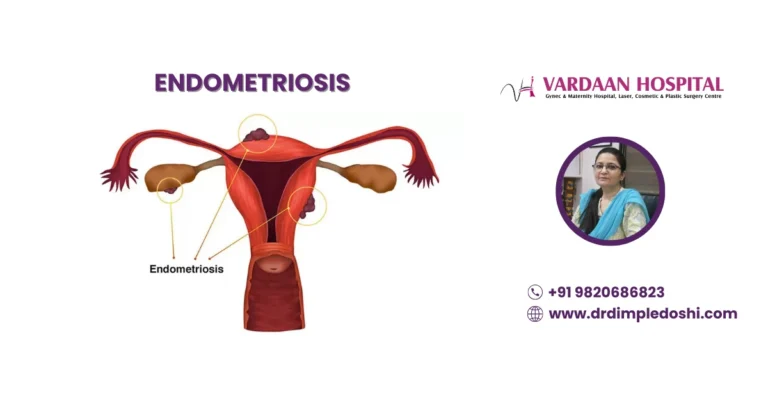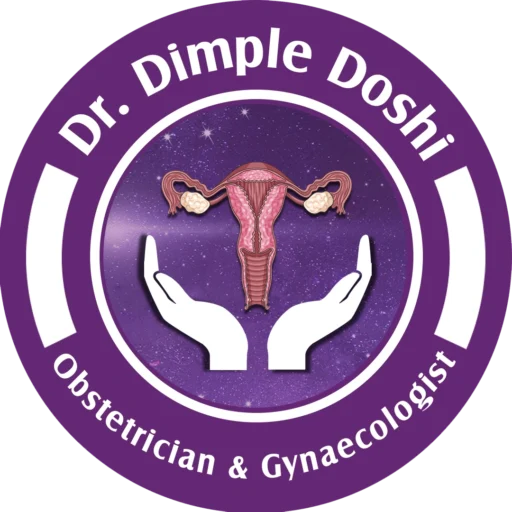Specialized Endometriosis Care in Goregaon West, Mumbai

What is Endometriosis?
Endometriosis means, endo(inside) metri(uterus) osis(disease). Endometriosis symptoms leave women in a continuous feeling of exhaustion. This condition is complex. Because, the tissue present inside your uterus, which appears the same as the lining, expands upward outside the uterus. This tissue is not supposed to grow where it doesn’t belong. This external tissue growth may leave you experiencing inflammation, scarring, and severe endometriosis pain. Most women may misunderstand and overlook endometriosis. This may leave women grappling with invisible pain. The tissue grown outside the uterus will respond to hormonal changes during your menstrual cycle. This may leave you experiencing heavy bleeding and invite infertility.
What causes endometriosis?
Endometriosis causes include:
- Retrograde menstruation: Menstrual blood flows backward into the pelvic cavity. This will transfer endometrial cells into your ovaries and fallopian tubes.
- Hormonal imbalance: High levels of estrogen can fuel the growth of endometrial-like tissue.
- Immune dysfunction: Your immune system may fail to recognize and eliminate the misplaced tissue.
- Genetic predisposition: Family history of experiencing the condition plays a key role in causing endometriosis. There is about a six fold increased incidence of endometriosis in women with the affected first-degree relative.
- Cellular metaplasia: When your cells change from one form to another, cells outside the uterus change into endometrial-like cells and start to grow.
- Stem cells: These cells spreading through your body via blood and lymphatic vessels can also cause endometriosis. These stem cells are capable of turning into the cells responsible for the development of endometriosis.
- Complex condition: This condition globally affects women in the reproductive age group regardless of their ethnic origin.
- High Estrogen: Prolonged exposure to estrogen as in late menopause or early stage of menses.
- Other causes: congenital abnormalities of the uterus and vagina. Impaired immunity, localized complex hormonal influences, environmental contaminants etc.
Signs and Symptoms of endometriosis
Endometriosis symptoms vary widely among women. They include:
- Chronic pelvic pain. Especially during menstruation
- Pain during intercourse (dyspareunia)
- Painful bowel movements or urination
- Heavy and irregular menstrual bleeding
- Fatigue, bloating, and nausea
- Endometriosis causes infertility as well to some women
Impact of endometriosis
Endometriosis can impact key aspects of a woman’s life including:
- Physical health
- Emotional health
- Social life
- Financial strain
Side effects and risks
Endometriosis left unchecked can lead to:
- Formation of ovarian cysts (endometriomas)
- Adhesions that bind organs together
- Bowel and bladder complications
- Increased risk of ovarian cancer
- Emotional exhaustion and burnout
How to avoid getting endometriosis
There’s no guaranteed prevention for endometriosis. However, taking proactive steps can reduce your risk of the condition.
Maintain hormonal balance
- Take endometriosis diet rich in anti-inflammatory foods.
- Avoid processed sugars.
- Manage stress. Meditation and leisure can help.
Limit estrogen exposure
- Reduce intake of environmental toxins like BPA (found in plastics).
Regular exercise
- Light exercise regularly can help you regulate and balance hormone levels.
Track menstrual health
- Irregularities in your menstrual cycle may signal endometriosis and any underlying condition.
Early intervention
- Once you start getting persistent pelvic pain or abnormal symptoms, consult your nearest gynecologist.
Avoid alcohol
- Avoid at least large amounts of alcohol. Alcohol raises estrogen levels. No more than one drink per day is recommended for women seeking relief from endometriosis
Avoid caffeine
- Avoid taking caffeinated drinks more than once a day. Studies show that drinking more than one caffeinated drink a day, especially sodas and green tea, can raise estrogen levels.
Reduce estrogen rich diet
- Reduce your intake of estrogen rich foods like soy milk, TOFU, soyabean , flax seeds, sesame seeds, garlic, dried fruits etc.
Diagnosis of endometriosis
Endometriosis diagnosis requires a persistence and specialized care including:
- Pelvic examination
- Ultrasound or MRI tests
- Laparoscopy
It is safe to consult a doctor with expertise in minimally invasive gynecological surgeries. This will help you get an accurate diagnosis.
Treatment for endometriosis
Treating endometriosis requires a comprehensive, individualized approach:
Surgical intervention
- Endometriosis surgery requires the use of laparoscopic technique to remove endometrial tissue, adhesions, and cysts.
Hormonal therapy
- Medications will be prescribed by your doctor to reduce menstrual cycle.
- This is for avoiding further growth of endometrial tissue outside your uterus.
Lifestyle adjustments
- Take anti-inflammatory diets
- Manage stress with meditation and leisure
- Physical therapy can also help
Medications for endometriosis
Medications can provide temporary relief. These include:
Pain relievers
- NSAIDs like ibuprofen to reduce inflammation.
Hormonal therapy
- Gonadotropin-releasing hormone (GnRH) agonists
- Oral contraceptives
- Progestin therapy
Fertility treatments
- If you are trying or planning to conceive, medications prescribed by your doctor can help stimulate ovulation.
Right time to consult doctor
Don’t wait for symptoms to become unbearable. Consult your nearest gynecologist if you experience:
- Severe pelvic pain even after using painkillers
- Pain during intercourse or bowel movements
- Heavy menstrual bleeding
- Difficulty giving birth after six months to a year of trying
Best Endometriosis Doctor & Specialist in Mumbai
Dr. Dimple Doshi at Vardaan Hospital known for providing relief to women experiencing various and invincible gynecological conditions. Her expertise, combined with ‘will’ she honed as a child to see no women suffer is seen on patients’ smiles.
What inspires Dr. Doshi is to see women from all walks of life living in right health.
What happens if endometriosis left untreated
Ignoring endometriosis can lead to:
- Permanent damage to reproductive organs
- Severe chronic pain that can worsen over time
- Bowel and urinary complications
- Emotional, physical and mental health challenges
Early intervention by your doctor can direct you to a life of relief.
Key points to Keep in mind
- Endometriosis is a condition of experiencing ‘bad cramps’.
- It’s a serious medical condition and requires timely professional intervention.
- Track your menstrual symptoms and take regular consultations with your doctor.
- Don’t delay seeking help when things go out of the way.
- Early intervention can preserve your fertility and quality of life.
You are not alone. With the right care, support, and determination, it is possible to manage endometriosis and lead a life of relief.
Take charge of your health today.
Frequently Asked Questions
Q1) Is endometriosis genetic?
Ans. Yes, genetics can play a role. Women with a family history of endometriosis are more likely to develop it.
Q2) Who can get endometriosis?
Ans. Endometriosis can affect anyone with a uterus, in their reproductive years, between 15-49 years of age.
Q3) Does endometriosis stay permanently?
Ans. There’s no definitive cure for endometriosis. Its symptoms can be managed effectively with your doctor’s help. Hormonal changes after menopause can reduce its impact.
Q4) Can I get a permanent cure for endometriosis?
Ans. There’s no permanent cure. Surgical intervention, hormonal treatments, and lifestyle adjustments can control and manage symptoms.
Q5) Does endometriosis cause cancer?
Ans. Endometriosis rarely leads to cancer, but some studies suggest a slight increase in the risk of ovarian cancer in women with the condition.
Q6) What should I avoid drinking with endometriosis?
Ans. Avoid alcohol and caffeinated drinks as they can increase estrogen levels, worsen symptoms.
Q7) Shall I drink boiled water to manage endometriosis?
Ans. Drinking boiled or filtered water is safe and can help avoid toxins.
Q8) Will I gain weight with endometriosis?
Ans. Weight gain isn’t directly caused by endometriosis, but hormonal treatments and inflammation may contribute. Focus on anti-inflammatory diets and regular exercise to keep your weight in control.
Q9) Can I enjoy sex with endometriosis?
Ans. Sex is painful with endometriosis. Proper treatment, physical therapy, and open communication with your partner can help you both figure out alternatives to keep your sexual life enticing.
Q10) How to manage health with endometriosis?
Ans. Follow an anti-inflammatory diet. Practice stress management through yoga and meditation. Stay physically active. Seek regular medical care to monitor and treat symptoms timely.
Medical code for endometriosis
✅ ICD-10-CM Codes (Diagnosis Codes) for Endometriosis
Endometriosis can affect different areas, so the ICD-10 codes are location-specific:
| Code | Description |
|---|---|
| N80.0 | Endometriosis of uterus |
| N80.1 | Endometriosis of ovary |
| N80.2 | Endometriosis of fallopian tube |
| N80.3 | Endometriosis of pelvic peritoneum |
| N80.4 | Endometriosis of rectovaginal septum and vagina |
| N80.5 | Endometriosis of intestine |
| N80.6 | Endometriosis in cutaneous scar |
| N80.8 | Other endometriosis |
| N80.9 | Endometriosis, unspecified |
✅ Common CPT Codes (Procedure Codes) for Surgical Treatment
Depending on the type of treatment (diagnostic or surgical), different CPT codes are used:
Diagnostic & Surgical Laparoscopy
| Code | Description |
|---|---|
| 49320 | Diagnostic laparoscopy (peritoneoscopy) |
| 58662 | Laparoscopy, surgical; with fulguration or excision of lesions of the ovary, pelvic viscera, or peritoneal surface (e.g., endometriosis) |
Open Surgical Procedures
| Code | Description |
|---|---|
| 58140 | Myomectomy, excision of fibroid tumors from uterus |
| 58150 | Total abdominal hysterectomy |
| 58260 | Vaginal hysterectomy, for uterus 250 grams or less |
| 58558 | Hysteroscopy, surgical; with sampling (biopsy) of endometrium and/or polypectomy |
Additional Codes If Involved
| Code | Description |
|---|---|
| 58940 | Oophorectomy, unilateral or bilateral |
| 58661 | Laparoscopy, surgical; with removal of adnexal structures (partial or total oophorectomy and/or salpingectomy) |

